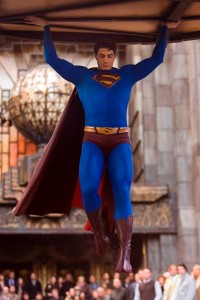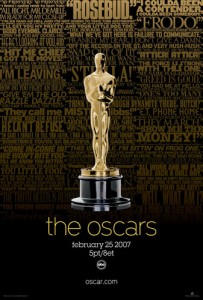The nominations for the 79th Academy Awards were announced this morning. The three films nominated for the visual effects Oscar were chosen from group of seven films. Find out the process behind them getting nominated, and how the bake off decided on these 3 films above all others.
![]() Nominations for the 79th Academy Awards were announced on Tuesday, January 23, 2007, at 5:30 a.m. PST in the Academy’s Samuel Goldwyn Theater.
Nominations for the 79th Academy Awards were announced on Tuesday, January 23, 2007, at 5:30 a.m. PST in the Academy’s Samuel Goldwyn Theater.
The nominees for visual effects are:
Pirates of the Caribbean: Dead Mans Chest
John Knoll, Hal Hickel, Charles Gibson and Allen Hall
Poseidon
Boyd Shermis, Kim Libreri, Chaz Jarrett and John Frazier
Superman Returns
Mark Stetson, Neil Corbould, Richard R. Hoover and Jon Thum
For Poseidon and Superman Returns the visual effects nominations are the only Oscar nominations for the films. Pirates of the Caribbean was also nominated for Achievement in Art Direction, Achievement in Sound Editing and Achievement in Sound Mixing.
For a complete list of nominees visit oscar.com.
So how did the bake off arrive at these films, how did the seven bakeoff invitees become 3 nominations?
At this year’s Academy of Motion Picture Arts and Sciences visual effects award nominations screening — more popularly known as the Visual Effects Oscar Bake-Off seven films were in consideration for achievement in Visual Effects for the 79th Academy Awards®.

The films below were listed included in this year’s short list or bakeoff:
“Casino Royaleâ€
“Eragonâ€
“Night at the Museumâ€
“Pirates of the Caribbean: Dead Man’s Chestâ€
“Poseidonâ€
“Superman Returnsâ€
“X-Men The Last Standâ€
On Wednesday, January 17, the Academy’s Visual Effects Award nominating committee screened seven 15-minute film excerpts from each of the shortlisted films. Following the screenings, members voted to nominate three films for Oscar consideration.
What did those films do to earn that honor? What is the yard stick by which they are measured?
There is no easy answer to this question. The Academy’s guidelines leave plenty of room for interpretation: “consideration of the contribution the visual effects make to the overall production, and the artistry, skill, and fidelity with which the visual illusions are achieved.â€
Clearly just making the bakeoff is a huge deal. Films are selected and then a list is narrowed down to the final seven.
According to Richard Edlund, the executive committee, a group of 35 people from the effects branch picks five additional industry veterans to add to its ranks and becomes what Edlund calls “a 40-person steering committee.†That group evaluates an average of 250-plus films each year that are officially listed by the Academy as containing visual effects, and over time, it winnows that number down to between 20 to 30 films, and later, 10 to 15 that feature “significant effects that could be considered representative of our industry,†stated Edlund in a 2002 Millimeter story.
“We debate until we get down to 10 to 15,†he says, “and then, the committee votes on seven for the Bake-Off. We then send letters to the producers of those movies, asking them to name the four most deserving and important people in the visual effects area associated with those films, and those people are listed as the ones eligible for the Oscar if their work is nominated. They are the ones who come to the Bake-Off and explain the work.â€
Edlund says producers of the film suggest the four names, but he adds that the effects branch reserves the right to perform due diligence and alter those names if necessary. In some years less than 3 and rarely more than 4 names then get written into visual effects history as Oscar nominees.
Some history
Again quoting the Millimeter story:
There is no formula for this. The award started out in 1939 as a “special effects†award — the Achievement in Special Effects Oscar. In 1964, it became known as the Achievement in Special Visual Effects award, and in 1972, it became Special Achievement in Visual Effects. These days, it’s known as the Achievement in Visual Effects award. (Special Achievement in Visual Effects was last handed out in 1990 for Total Recall, and it is still a possibility if the effects branch ever decides one particular film’s work is so far above the field that it alone should be nominated, and therefore, it wins the special Oscar. This happened periodically throughout the 1970s and 1980s. In 1995, only two films survived the Bake-Off — Apollo 13 and Babe, which won the Oscar.)
The award is now a “visual effects†award, however — a reference to the depth and breadth of the different methods of creating effects, including, but no longer limited to, mechanical methods. Most agree that while nothing is openly discussed – it is very hard to win unless you have some originality, something that has led to being nominated for any kind of Epic Space battle film extremely hard indeed.
The Oscar for Visual Effects is not the only visual effects awards given, there are many proud individuals who are deservedly singled out for recongnition in the area of technical craft. These technical oscars are not limited to visual effects but the effects community has been well represented over the last 30 years or so.
 Each film’s Oscar nominees are responsible for preparing white papers and packets of still images and press clippings for Academy branch members to study in the weeks prior to the Bake-Off. One of the most influencial press clipping is a reprint from Cinefex magazine. This year as in previous years – reprints were sent out, with Cinefex’s permission. These limited print run reprints have become collectors items in their own right, such as this years Xmen Cinefex reprint. But without a doubt, winners and losers comment that the 15-minute effects highlight reel is the most key aspect of any Oscar campaign.
Each film’s Oscar nominees are responsible for preparing white papers and packets of still images and press clippings for Academy branch members to study in the weeks prior to the Bake-Off. One of the most influencial press clipping is a reprint from Cinefex magazine. This year as in previous years – reprints were sent out, with Cinefex’s permission. These limited print run reprints have become collectors items in their own right, such as this years Xmen Cinefex reprint. But without a doubt, winners and losers comment that the 15-minute effects highlight reel is the most key aspect of any Oscar campaign.
Bake-Off rules are very specific — presenters have only three minutes to introduce the reel, 15 minutes to show the reel (in random order picked from a hat), and five minutes to answer questions about the reel, all under the watchful glare of the ever-present “red light†at the Academy theater in Beverly Hills. No “making of†reels or other marketing techniques are permitted prior to, or during, the Bake-Off. “We tried behind-the-scenes reels for a couple years, but scrapped the idea because some studios were better at producing them than others,†says Edlund. “We felt the work that actually made it onto the screen should be the only thing that mattered.†The Reels must be from the film and not from the trailer or any special version of the film, and the only sound is must be from the soundtrack. This restriction can make for some unusual reels. Jeff Heusser says “I remember the 1999 bake-off where the reel for the film Sleepy Hollow was shown. It was a lot of scenes back to back of the headless horseman decapitating people”. (IMDB trivia says there were 18 decapitations in the film).
Famously when James Cameron presented the reel for Titanic (which later won), the red light came on indicating time was up, he just reached over and unscrewed the red light bulb and joked that if he’d learned anything – it was that some things can not be rushed.
Winners are then selected from the Nominees by the members of the Academy of Motion Picture Arts and Sciences. Typically films that win are either huge effects films – or films that do something very new and original. In all cases the quality of the rest of the film seems to still play a role, great effects in a bad movie seldom win.
Academy Awards for outstanding film achievements of 2006 will be presented on Sunday, February 25, 2007, at the Kodak Theatre at Hollywood & Highland Center®, and televised live by the ABC Television Network at 5 p.m. PST.
At fxguide we would like to join the general film community in congratulating the work of all the artists in this years Bake off and especially those involved with the three nominated films. Good luck on Oscar night!
